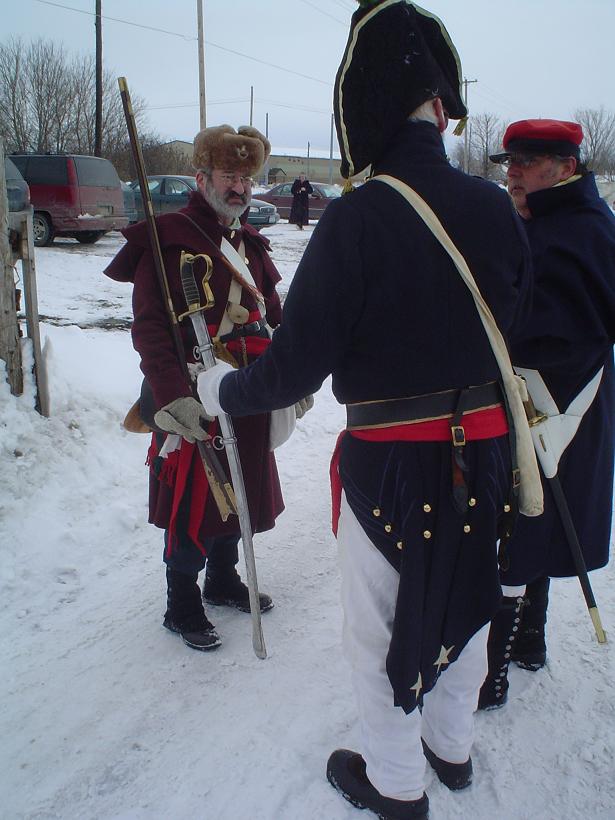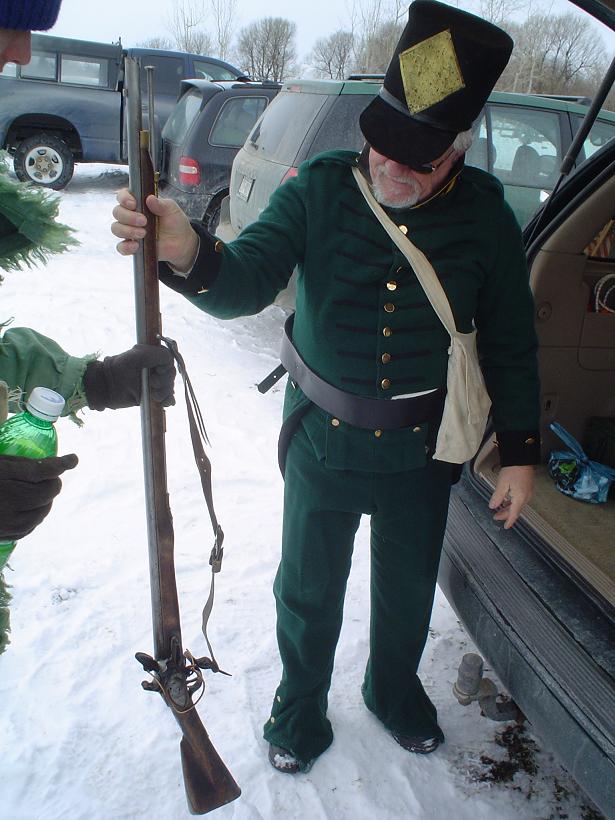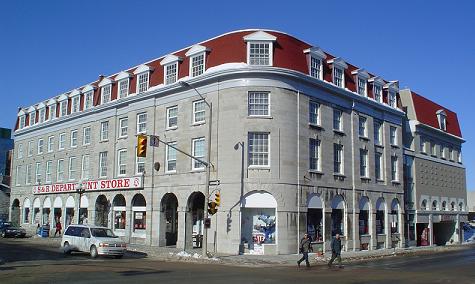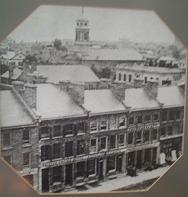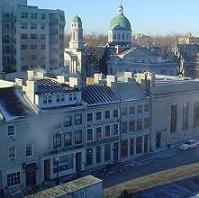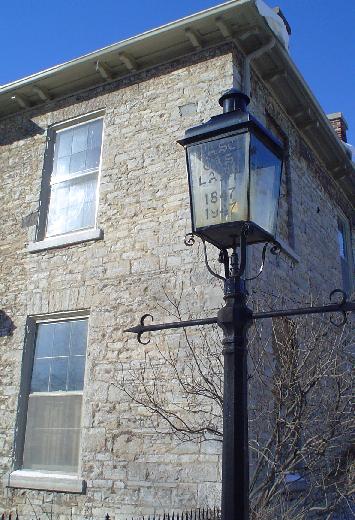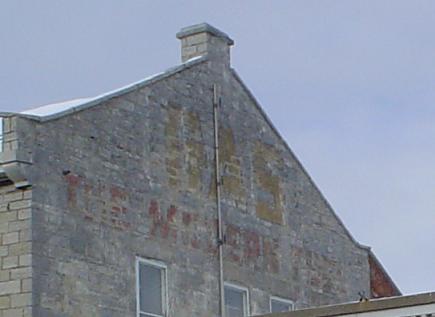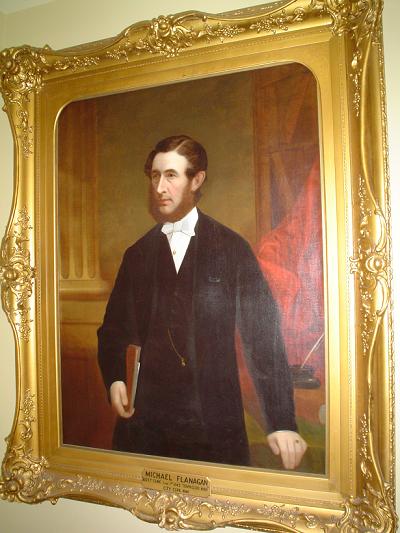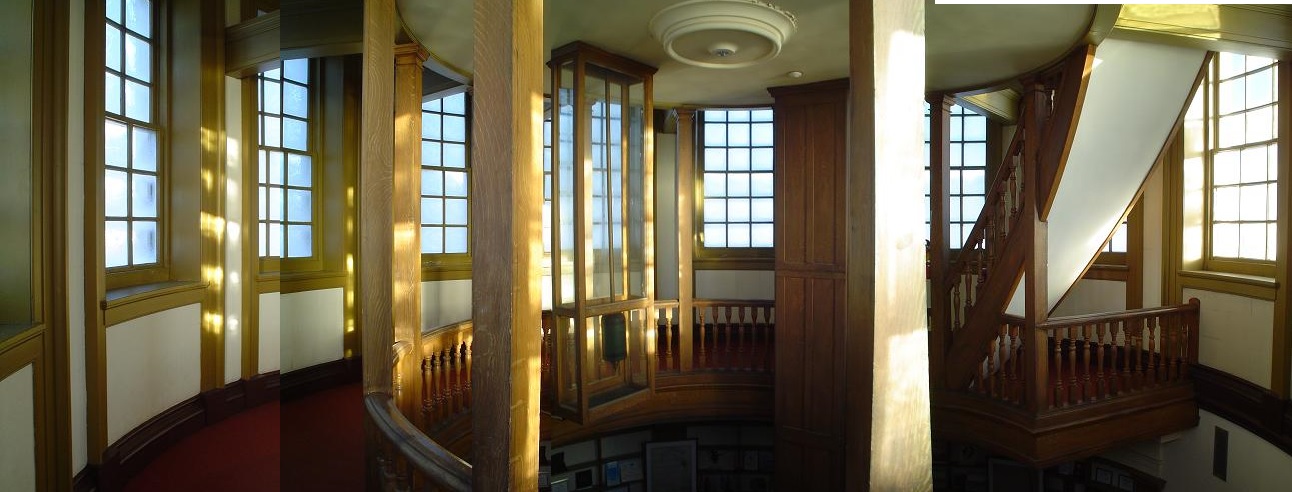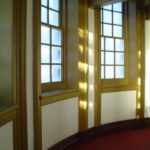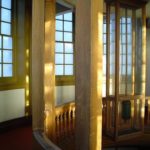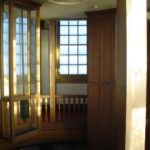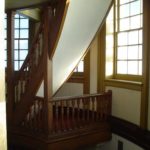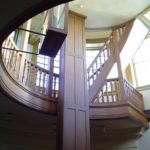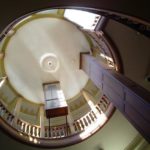Martello towers guard the mouth of the Rideau. There are actually three in the picture, the third hidden by the trees to the left. It stands out in the mist better here. Built in the 1840s to protect the then high-tech canal technology of the Rideau accessed between the nearest two towers, the theory was similar to Halifax Harbour’s defences – a killing zone of miles deterring any thought of attack. One gun in the red roofed tower to the left had a range of 7 miles. Greater detail and a harbour map can be found here.
Category: Ontario
Men at Serious Play
So we went over to St. Lawrence County, New York, on Saturday to catch a War of 1812 re-enactment of the Battle of Ogdensburg organized by a local group, Forsyth’s Rifles Inc.. We were not disappointed. I had never been to one of these things before – other than being a mock soldier at Citidel Hill in Halifax for one day (I got sun stroke in the shade) – and so in had some pre-conceptions that, on one hand, it would be like a radio nerd convention and, on the other, a bit gungho.
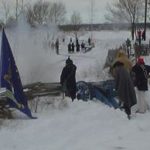 It was neither. About 60 guys, who could very well have been all high school history from either side of the river/border, played out the actual battle with some authenticity for over about an hour. They were quite happy to answer all questions and made sure everyone kep a safe distance. The grey-coated British advanced over the ice in formation, cannons roared from both sides and fifes were played. It was quite cold and a couple guys said they were considering taking Walmart and holding it instead.
It was neither. About 60 guys, who could very well have been all high school history from either side of the river/border, played out the actual battle with some authenticity for over about an hour. They were quite happy to answer all questions and made sure everyone kep a safe distance. The grey-coated British advanced over the ice in formation, cannons roared from both sides and fifes were played. It was quite cold and a couple guys said they were considering taking Walmart and holding it instead.
I wrote earlier this month on the events and provided links in that post. A year later in the War of 1812, the USA invaded Eastern Ontario and got hammered at Chrysler’s Farm where a much smaller force protected Montreal against 8000 soldiers (including the real Forsyth’s unit) coming up the river from Sackett’s Harbor. There is a bigger re-enactment in summer of that battle which we will likely take in. The Ogdensburg guys head over for that.
Some short movies of the action – all around 2 Mbs so expect some delay
The fifes play as the battle nears
The US forces march out to meet the Brits
a US cannon fires
The US musketmen are ordered to fire at will – note small Brit snowshoe unit coming up to the left in trees
Please give me a heads up if any of the links in the multi-media post do not work.
Napanee
Good Planning
Pub, Art, Hair, Curry, Texmex. I like this block – kitty corner to S&R – which incorporates a 1870’s firehall, some limestones a few decades older as well as a new brick build with a hair place that fits in the scheme. Next to it, tucked behind down the alley to the right is Curry Village, one of the great Indian restaurants in the downtown. Behind to the left you’ll see a Holiday Inn which was built on an old wharf like others in the downtown – rather than on land occupied by historic buildings. At the intersection, Cornerstone is a private art gallery with Inuit art among other things. The 1876 firehall half shown to the right of the picture is a Lonestar. To the left, the newish pub Merchant MacLiam built in the last year or two fills the oldest space in the scene, an 1840 warehouse with a very similar build to Halifax’s Lower Deck with more of a Middle Deck crowd. The pub, curry and texmex all meet in patios at the back with view of the river.
Snar
Built largely in 1820 as some kind of markethouse, the S&R Department is a landmark in Kingston, being something of a Margolians of Truro but at the same time selling a broader range of stuff than just clothes and shoes including some groceries, drugs and, up on the top floor, hardware, toys and linens. I don’t know what the “S” and the “R” stands for but in local accent it is pretty much pronounced “snar”. – and just to prove these are the end times, even they have a web site where we find the answer to my question:
The 175 year old limestone building that houses S&R was an integral part of the downtown long before the store came into being more than 40 years ago. It was designed by the same architect as Kingston’s City Hall (George Browne) and constructed in 1817. Among other things, it has been a merchandise mart (1860’s), piano factory (1890’s) and a barracks during W.W.II. S&R was opened in 1959 by Maurice Smith and Percy Robinson after extensive heritage renovations.
Five Hundred
Five hundred posts in around nine months. I received my congratulatory prizes from Portland the other day: a T-shirt from a deep sea fishing outfit from California and a wind-up radio that includes a warning not to wind up until the batteries have had 5 hours charge from a 12 volt adapter (not included). So in honour of the passage of time a side-by-side shot to the southwest from the dome.
Two images of the same view mid-19th century and early 21st
I noticed the older photo down a hallway at work, a view from the dome of City Hall which I have twinned with one of my own from a couple of weeks ago. According to the St. George’s Cathedral history, the older photo must be from between 1838 and 1862 as you can see the second larger dome built in the latter year is not present. So it is around 150 years older than my shot from the other day. The church’s predecessor, more on the actual market square the row of houses to the bottom of each photo face, is the location of the declaration of government in Ontario in 1792:
John Stuart, “Father of the Anglican Church in Upper Canada”, was the Rector. On July 8th, Lieutenant Governor John Simcoe, standing on the steps of St. George’s Church, took “the required oaths” of office and read the Royal Commissions, thus connecting St. George’s with the beginnings of provincial government in Ontario.
The actual date of the first European settlement in Kingston was 1673 by the French at Fort Frontenac. La Salle, the great explorer [after whom a car was named and referenced in the All in the Family theme sung by Archie and Edith Bunker] was the first seigneur and used the fort as a base for his explorations into the interior..which did not turn out all rosy. In 1758 Fort Frontenac was taken by the English. Ransacked and abandoned, it remained unoccupied for the next 25 years. [An interactive map of the entire St. Lawrence area starting with Fort Frontenac in the west from 1776 is here.] In 1783, Major Samuel Holland was sent to survey the condition of the fort, and in the same year temporary barrack facilities were constucted. Sammy is well known in PEI as its first surveyor (though it was only a part of his larger works) and the briefly celebrated namesake of Samuel Holland Institute of Technology (a joke since at least 1993 – scroll down page) which was soon renamed Holland Collage.
157 Years Of 25 Watts Of Power
The glass reads “Last Gas Lamp 1847 – 1947.” This is the lamp I referred to the other day. I passed it heading to Queens walking down King Street to do the seminar on section 7 Charter “liberty” and biometric surveillance. It is odd doing public talking when I am not being marked, looking for a client or trying to keep a client out of jail…
Notice that the light is on – that’s the yellow glow behind the 1947.
Painted Wall
It reads “GAS THE MODERN FUEL” and I noticed this near the foot of Queen Street by Ontario, seen from behind S&R. It is pretty faded but a really nice font. The municipality has run natural gas distribution since the 1800s. This is near the old gas works site. Here is some info on city gas works in Canada. There is still one last gas street lamp lit dating from 1847 on King Street East near William.
Michael Flanagan, Esq.
More civic art. I noticed this week these two frames on the walls of the third floor. They are not side by side but they relate to the same man, Michael Flanagan, Esq. who was City clerk from 1846 to 1893 and after – and a junior clerk before that position was his. The painting is from 1846. The certificate below is from 1893. An amazing span of time in a working life of a Canadian, he would have been a perhaps a teen when Kingston was the capital of Canada in 1841, would have watched the building of City Hall and the fortifications at the harbour mouth protecting the Rideau canal and also during his career would have seen the electronic and instant messaging era of telegraph and telephone.
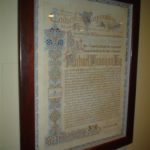 If you click on the certificate you will see a large version which may be readable despite the nutty font and my browser’s automatic reduction of the scale. At about two-thirds of the way down, there is a passage which any of you can feel free to apply to me:
If you click on the certificate you will see a large version which may be readable despite the nutty font and my browser’s automatic reduction of the scale. At about two-thirds of the way down, there is a passage which any of you can feel free to apply to me:
Those of our citizens who have had the privilege of meeting him in private life will not soon forget the attraction of his genial society and the charm of his vivacious conversation enlivened as it is by unfailing anecdote and suggestive reminiscences brought forth from the treasury of a singular retentive memory and all pervaded by a spirit of kindest sympathy for his fellowmen.
Most interesting is the fact that this is not a retirement document as he is wished many years of good health to continue serving his fellow citizens.




